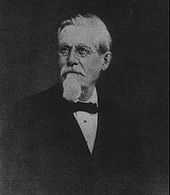Jaime Nunó

Jaime Nunó Roca (September 8, 1824 – July 18, 1908) was a Spanish composer who composed music for Mexico's national anthem.
He was born on September 8, 1824 in Sant Joan de les Abadesses, a town in the province of Girona, in Catalonia, Spain. Both his parents, Francisco Nunó and Magdalena Roca, died before his ninth birthday. After their death, Nunó was raised by his uncle Bernard, a seller of silks in Barcelona, who financed his musical studies in that city. There he demonstrated his skill as a soloist in the city cathedral, for which he gained a scholarship to study with the composer Saverio Mercadante in Italy. Upon his return to Barcelona, he was named director of the Queen's Regimental Band in 1851 and travelled with them to Cuba where he met and befriended Antonio López de Santa Anna, the former Mexican president.
When Santa Anna returned to Mexico in 1853 to again resume the office of president, he invited Jaime Nunó to lead the Mexican military bands. His arrival coincided with the national call to compose the Mexican National Anthem. Nunó participated, composing music for the lyrics of Mexican poet Francisco González Bocanegra, and was declared the winner on August 12, 1854.
After the overthrow of President Santa Anna, Nunó emigrated to the United States, where he worked as a conductor and opera director. One of the operas he directed toured the Americas in 1864. After a time in Spain, he returned to the U.S. and settled in New York, where he was found by a Mexican journalist in 1901. When this news reached Mexico, the current president, Porfirio Díaz, invited him to return; he did so and received various honors between 1901 and 1904. He died in New York on July 18, 1908. In 1942 the Mexican government ordered that his remains be exhumed and interred in the Rotonda de los Hombres Ilustres (Rotunda of Illustrious Men) in Mexico City, where they remain.
Rediscovery
In 2010, coinciding with the bicentennial of Mexico's independence, the Catalan musicologists Cristian Canton and Raquel Tovar located the only descendant of Jaime Nunó, his grandson, living in the United States (Pelham, NY).[1] The family granted access to the personal archive of Jaime Nunó, containing about 5,000 unpublished documents (personal letters, scores, official documents, etc.); all this information allowed Canton and Tovar writing the first complete biography of Nunó.[2] This book had a high media coverage and has been described as "an essential title to understand the musical history of Mexico".[3] Also, in the context of the rediscovery of the figure of Jaume Nunó, his native town, Sant Joan de les Abadesses, opened a museum dedicated to the composer in his birth house, known as El Palmàs.[4] Since the recovery of these documents, the unpublished music of Jaime Nunó has been played again,[5][6] a complete edition of his works was published in 2012 and a recording of them is expected in 2014.
References
- ↑ Figueroa, Adrián (27 January 2011). "Hallan baúl con 15 partituras inéditas escritas por Jaime Nunó; contiene la batuta con la que dirigió por primera vez el Himno Nacional". Crónica (in Spanish) (Mexico City). Retrieved 12 March 2014.
- ↑ Canton, Raquel; Tovar (2010). Jaume Nunó. Un santjoaní a Amèrica. Ajuntament de Sant Joan de les Abadesses and Casa Amèrica-Catalunya. ISBN 978-84-85736-54-6.
- ↑ Azar, Lázaro (31 January 2010). "Lo bueno del año que se va". Reforma (in Spanish) (Mexico City).
- ↑ Vilarodà, Jordi (19 June 2010). "Sant Joan recupera la casa i la història de Jaume Nunó, l'autor de l'himne de Mèxic". El 9 Nou (in Catalan). Retrieved 12 March 2014.
- ↑ "Jaime Nunó - The days that are no more". Retrieved 19 February 2011.
- ↑ "Jaime Nunó - Ah how sweet it is to love". Retrieved 19 February 2011.
|